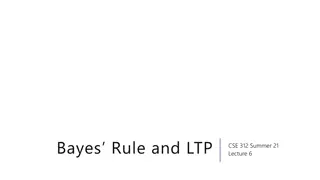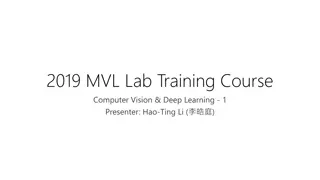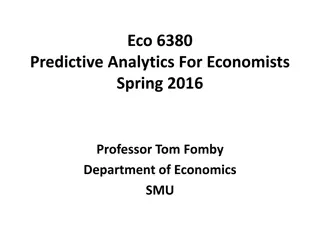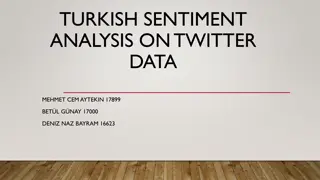Screw classifier
CraftsmenCrusher's screw classifier is an innovative solution designed to efficiently separate and dewater solids from liquids.
1 views • 1 slides
Understanding Conditional Probability and Bayes Theorem
Conditional probability relates the likelihood of an event to the occurrence of another event. Theorems such as the Multiplication Theorem and Bayes Theorem provide a framework to calculate probabilities based on prior information. Conditional probability is used to analyze scenarios like the relati
1 views • 5 slides
Counterfeit Detection Techniques in Currency to Combat Financial Fraud
Currency counterfeiting poses a significant challenge to the financial systems of countries worldwide, impacting economic growth. This study explores various counterfeit detection techniques, emphasizing machine learning and image processing, to enhance accuracy rates in identifying counterfeit curr
0 views • 15 slides
Understanding Evaluation and Validation Methods in Machine Learning
Classification algorithms in machine learning require evaluation to assess their performance. Techniques such as cross-validation and re-sampling help measure classifier accuracy. Multiple validation sets are essential for comparing algorithms effectively. Statistical distribution of errors aids in
0 views • 95 slides
Understanding Naive Bayes Classifiers and Bayes Theorem
Naive Bayes classifiers, based on Bayes' rules, are simple classification methods that make the naive assumption of attribute independence. Despite this assumption, Bayesian methods can still be effective. Bayes theorem is utilized for classification by combining prior knowledge with observed data,
0 views • 16 slides
Understanding Conditional Probability and Bayes Theorem
Conditional probability explores the likelihood of event A given event B, while Bayes Theorem provides a method to update the probability estimate of an event based on new information. Statistical concepts such as the multiplication rule, statistical independence, and the law of total probability ar
0 views • 15 slides
Introduction to Bayesian Classifiers in Data Mining
Bayesian classifiers are a key technique in data mining for solving classification problems using probabilistic frameworks. This involves understanding conditional probability, Bayes' theorem, and applying these concepts to make predictions based on given data. The process involves estimating poster
0 views • 20 slides
Building Sentiment Classifier Using Active Learning
Learn how to build a sentiment classifier for movie reviews and identify climate change-related sentences by leveraging active learning. The process involves downloading data, crowdsourcing labeling, and training classifiers to improve accuracy efficiently.
0 views • 47 slides
What to Expect of Classifiers: Reasoning about Logistic Regression with Missing Features
This research discusses common approaches in dealing with missing features in classifiers like logistic regression. It compares generative and discriminative models, exploring the idea of training separate models for feature distribution and classification. Expected Prediction is proposed as a princ
1 views • 19 slides
Understanding Confusion Matrix and Performance Measurement Metrics
Explore the concept of confusion matrix, a crucial tool in evaluating the performance of classifiers. Learn about True Positive, False Negative, False Positive, and True Negative classifications. Dive into performance evaluation metrics like Accuracy, True Positive Rate, False Positive Rate, False N
3 views • 13 slides
Understanding Naive Bayes Classifier in Data Science
Naive Bayes classifier is a probabilistic framework used in data science for classification problems. It leverages Bayes' Theorem to model probabilistic relationships between attributes and class variables. The classifier is particularly useful in scenarios where the relationship between attributes
1 views • 28 slides
Evaluating Website Fingerprinting Attacks on Tor
This research evaluates website fingerprinting attacks on the Tor network in the real world. It discusses the methodology of deanonymizing Tor users through predicting visited websites, emphasizing the need for labels to train machine learning classifiers. The study presents a threat model involving
0 views • 26 slides
Understanding Basic Classification Algorithms in Machine Learning
Learn about basic classification algorithms in machine learning and how they are used to build models for predicting new data. Explore classifiers like ZeroR, OneR, and Naive Bayes, along with practical examples and applications of the ZeroR algorithm. Understand the concepts of supervised learning
0 views • 38 slides
Text Classification and Naive Bayes in Action
In this content, Dan Jurafsky discusses various aspects of text classification and the application of Naive Bayes method. The tasks include spam detection, authorship identification, sentiment analysis, and more. Classification methods like hand-coded rules and supervised machine learning are explor
1 views • 82 slides
Understanding Text Classification Using Naive Bayes & Federalist Papers Authorship
Dive into the world of text classification, from spam detection to authorship identification, with a focus on Naive Bayes algorithm. Explore how Mosteller and Wallace used Bayesian methods to determine the authors of the Federalist Papers. Discover the gender and sentiment analysis aspects of text c
0 views • 71 slides
Understanding Bayes Theorem in NLP: Examples and Applications
Introduction to Bayes Theorem in Natural Language Processing (NLP) with detailed examples and applications. Explains how Bayes Theorem is used to calculate probabilities in diagnostic tests and to analyze various scenarios such as disease prediction and feature identification. Covers the concept of
0 views • 13 slides
Understanding Bayes Rule and Conditional Probability
Dive into the concept of Bayes Rule and conditional probability through a practical example involving Wonka Bars and a precise scale. Explore how conditional probabilities play a crucial role in determining the likelihood of certain events. Gain insights on reversing conditioning and applying Bayes
0 views • 35 slides
Solving the Golden Ticket Probability Puzzle with Bayes' Rule
In this scenario, Willy Wonka has hidden golden tickets in his Wonka Bars. With the help of a precise scale that alerts accurately based on whether a bar has a golden ticket or not, we calculate the probability of having a golden ticket when the scale signals a positive result. By applying condition
0 views • 33 slides
Understanding Image Classification in Computer Vision
Image Classification is a crucial task in Computer Vision where images are assigned single or multiple labels based on their content. The process involves training a classifier on a labeled dataset, evaluating its predictions, and using algorithms like Nearest Neighbor Classifier. Challenges and the
0 views • 16 slides
Enhancing Certification Exam Item Prediction with Machine Learning
Utilizing machine learning to predict Bloom's Taxonomy levels for certification exam items is explored in this study by Alan Mead and Chenxuan Zhou. The research investigates the effectiveness of a Naïve Bayesian classifier in predicting and distinguishing cognitive complexity levels. Through resea
0 views • 19 slides
Understanding Evaluation Metrics in Machine Learning
Explanation of the importance of metrics in machine learning, focusing on binary classifiers, thresholding, point metrics like accuracy and precision, summary metrics such as AU-ROC and AU-PRC, and the role of metrics in addressing class imbalance and failure scenarios. The content covers training o
0 views • 31 slides
Understanding Binary Outcome Prediction Models in Data Science
Categorical data outcomes often involve binary decisions, such as re-election of a president or customer satisfaction. Prediction models like logistic regression and Bayes classifier are used to make accurate predictions based on categorical and numerical features. Regression models, both discrimina
0 views • 67 slides
Effective Data Augmentation with Projection for Distillation
Data augmentation plays a crucial role in knowledge distillation processes, enhancing model performance by generating diverse training data. Techniques such as token replacement, representation interpolation, and rich semantics are explored in the context of improving image classifier performance. T
0 views • 13 slides
Understanding Bayes Rule and Its Historical Significance
Bayes Rule, a fundamental theorem in statistics, helps in updating probabilities based on new information. This rule involves reallocating credibility between possible states given prior knowledge and new data. The theorem was posthumously published by Thomas Bayes and has had a profound impact on s
0 views • 34 slides
Approximate Inference in Bayes Nets: Random vs. Rejection Sampling
Approximate inference methods in Bayes nets, such as random and rejection sampling, utilize Monte Carlo algorithms for stochastic sampling to estimate complex probabilities. Random sampling involves sampling in topological order, while rejection sampling generates samples from hard-to-sample distrib
0 views • 9 slides
Probability Basics and Problem Solving in Business Analytics I
Understanding the basic rules and principles of probability in business analytics, including conditional probability and Bayes Rule. Learn how to solve problems involving uncertainty by decomposition or simulation. Explore how beliefs can be updated using Bayes Rule with practical scenarios like ide
0 views • 13 slides
Understanding Classifier Performance in Target Marketing
Explore the importance of classifier performance in target marketing scenarios such as direct marketing, consumer retention, credit scoring, and bond ratings. Learn how to efficiently allocate resources, identify high-value prospects, and evaluate classifiers to maximize profit in marketing campaign
0 views • 23 slides
Linear Classifiers and Naive Bayes Models in Text Classification
This informative content covers the concepts of linear classifiers and Naive Bayes models in text classification. It discusses obtaining parameter values, indexing in Bag-of-Words, different algorithms, feature representations, and parameter learning methods in detail.
0 views • 38 slides
Evolutionary Computation and Genetic Algorithms Overview
Explore the world of evolutionary computation and genetic algorithms through a presentation outlining the concepts of genetic algorithms, parallel genetic algorithms, genetic programming, evolution strategies, classifier systems, and evolution programming. Delve into scenarios in the forest where gi
0 views • 51 slides
Understanding Model Evaluation in Business Intelligence and Analytics
Explore the importance of measuring model performance, distinguishing between good and bad outcomes, evaluating accuracy using confusion matrices, and the significance of the confusion matrix in analyzing classifier decisions.
0 views • 31 slides
Introduction to Bayes' Rule: Understanding Probabilistic Inference
An overview of Bayes' rule, a fundamental concept in probabilistic inference, is presented in this text. It explains how to calculate conditional probabilities, likelihoods, priors, and posterior probabilities using Bayes' rule through examples like determining the likelihood of rain based on a wet
0 views • 21 slides
Understanding Bayes Classifier in Pattern Recognition
Bayes Classifier is a simple probabilistic classifier that minimizes error probability by utilizing prior and posterior probabilities. It assigns class labels based on maximum posterior probability, making it an optimal tool for classification tasks. This chapter covers the Bayes Theorem, classifica
0 views • 24 slides
Decoupling Learning Rates Using Empirical Bayes: Optimization Strategy
Decoupling learning rates through an Empirical Bayes approach to optimize model convergence: prioritizing first-order features over second-order features improves convergence speed and efficiency. A detailed study on the impact of observation rates on different feature orders and the benefits of seq
0 views • 25 slides
Bayesian Meta-Prior Learning Using Empirical Bayes: A Framework for Sequential Decision Making Under Uncertainty
Explore the innovative framework proposed by Sareh Nabi at the University of Washington for Bayesian meta-prior learning using empirical Bayes. The framework aims to optimize ad layout and classification problems efficiently by decoupling learning rates of model parameters. Learn about the Multi-Arm
0 views • 27 slides
Implementing Turkish Sentiment Analysis on Twitter Data Using Semi-Supervised Learning
This project involved gathering a substantial amount of Twitter data for sentiment analysis, including 1717 negative and 687 positive tweets. The data labeling process was initially manual but later automated using a semi-supervised learning technique. A Naive Bayes Classifier was trained using a Ba
0 views • 17 slides
NSH_SFC 17.01 Performance Report Summary
The NSH_SFC 17.01 Performance Report focuses on measuring and analyzing the performance of various elements such as Service Function Forwarder, NSH Proxy, NSH Classifier, and more in the context of VPP 17.01 for different SFC ingredients. Baseline performance is established using IXIA-based PacketGe
0 views • 7 slides
Understanding Statistical Classifiers in Computer Vision
Exploring statistical classifiers such as Support Vector Machines and Neural Networks in the context of computer vision. Topics covered include decision-making using statistics, feature naming conventions, classifier types, distance measures, and more.
0 views • 39 slides
Understanding MitoCarta and Naive Bayes Integration in Excel Tutorial
Explore the process of calculating Naive Bayes log-odds scores and ROC curves in Excel using the MitoCarta dataset. Discover the best experimental techniques for isolating mitochondria in Arabidopsis studies, comparing methods like differential centrifugation and affinity purification.
0 views • 31 slides
Bayes’ Rule
Bayes Rule, a fundamental concept in statistics, explores how prior beliefs are updated based on new evidence. This rule, named after Thomas Bayes, has had a profound impact on statistical inference and has been further developed by mathematicians like Laplace. Exploring the probabilistic reasoning
0 views • 34 slides
Introduction to Machine Learning: Model Selection and Error Decomposition
This course covers topics such as model selection, error decomposition, bias-variance tradeoff, and classification using Naive Bayes. Students are required to implement linear regression, Naive Bayes, and logistic regression for homework. Important administrative information about deadlines, mid-ter
0 views • 42 slides







































